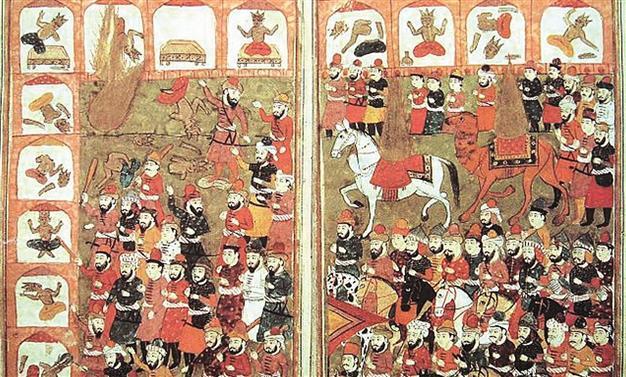Idols and the human figure in Islam
NIKI GAMM

The Prophet Muhammad destroyed the idols at the Ka’ba. L’Histoire Merveilleuse en Vers de Mohamet.
From ancient times before Islam it has been known that the tribes of the Arabian Peninsula had their own gods for whom altars or just stones were set up and on which they sacrificed animals. Figurative representations have been dated back to the first millennium B.C. and the remains of large temples have been found. The moon was the most widely worshipped, while a somewhat less influential god known as Allah was called upon on occasion.“These Arabian deities, which were of diverse nature, fell into different categories. Some of them were personifications of abstract ideas, such as jadd (luck), sa’d (fortunate, auspicious), rida’ (good will, favor), wadd (friendship, affection), and manaf (height, high place). Though originally abstract in character, they were conceived in a thoroughly concrete fashion,” according to Shaikh Inayatullah in “Pre Islamic Arabian Thought.”

Umayyad period.
But nowhere in the Qur’an does it say that idols are to be destroyed; however, later in the collections of the sayings and behavior of the Prophet (hadith), he is mentioned as having purified the Ka’ba by driving the idols out. Scholars over the centuries have had divergent views over the authenticity of these collections ranging from complete acceptance to total rejection. One of the major divisions between the Sunni and Shiite branches of Islam is caused by their accepting different sets of traditions.
Issa points to six hadiths which have some bearing on the issue and at the same time refuted them because they extended the meaning over time to include items which were not meant. For example, one of the most important of these concerned the Prophet Muhammad’s refusal to have anything in his home that contained the sign of the cross. However, this was interpreted as meaning anything with representations on it and that if there were such a thing, it was to be destroyed regardless of who owned it. On the other hand, Issa notes that the cross was the sign of Christianity and therefore should not be in a pious Muslim’s home.
In another example from the hadith, the Prophet is said to have said that angels would not enter a house in which there was either a representation or a dog. Representation was interpreted as meaning the image of a living creature, and this was considered to be a grave sin that was to be punished severely wherever it occurred. The idea behind this interpretation was that God had created living creatures; man could not. As Issa points out in his book, “Painting in Islam,” however, during his consideration of this interpretation, the commentator seems to forget that trees, mountains and other such items are also created by God but could be represented in art.

Archaeologists have discovered paintings on palace walls and the figures of human beings from the Umayyad period (661–750), that is, just 31 years after the death of the Prophet. The Arabs, on leaving the Arabian Peninsula, would have found temples and statues belonging to the Roman period and churches with frescoes from the Byzantines. Nor were they bothered by the use of coins with images.
The Prophet even is said to have accepted Byzantine coins as the dowry for his daughter, Fatima. In other words there was nothing against figural representations, painted or sculpted, as long as no one worshipped them in association with God or instead of God.
This situation apparently lasted until the period of the Byzantine iconoclasm which occurred between 726 and 787 and again between 814 and 842. During those two eras, religious imagery or icons were destroyed by the church on one side and the Byzantine imperial government on the other. One can be quite certain that the Arabs were well aware of the conflict between those who wanted religious imagery and those who didn’t. After all they were not just taking over territory Byzantine territory; they were also outside the walls of Constantinople trying to take the city.
In spite of what the various hadith said and commentators commented, a way forward was seen in two ways. One was to allow images that were two dimensional. This allowed painters to portray living creatures in miniature paintings and especially after the 15th century, puppet masters could continue to present the famous Karagöz plays. The other way was to show living creatures without shadows and, since Islamic miniature painting never developed ways of realistically portraying perspective unlike the Europeans, Muslim painters could readily work with such a decision.
In “The Koran Does Not Forbid Images of the Prophet” by Christiane Gruber, the author writes: “If we turn to Islamic law, there does not exist a single legal decree, or fatwa, in the historical corpus that explicitly and decisively prohibits figural imagery, including images of the Prophet. While more recent online fatwas can surely be found, the decree that comes closest to articulating this type of ban was published online in 2001 by the Taliban, as they set out to destroy the Buddhas of Bamiyan.”
Sculpture never got a start in the Muslim world and it was only in the second half of the 20th century that it became a respectable art form in Turkey – even if the sculptor was never able to earn a living from it.
Idol1- The Prophet Muhammad destroyed the idols at the Ka’ba. L’Histoire Merveilleuse en Vers de Mohamet.
Idol2- Allat, the mother goddess on a camel from Taif, Saudi Arabia, around 100 AD.
Idol3- A warrior from the Umayyad period.
Idol4- Head of a plaster statue from the Umayyad period.
Idol5- The Prophet Muhammad ascending to Heaven. Early 16th century
Idol6- The Prophet Muhammad. Late 16th century.
Idol7- Byzantine iconoclasm 9th century.
















